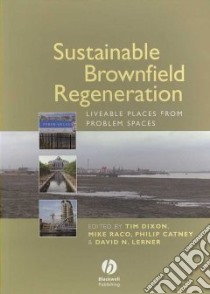Sustainable Brownfield Regeneration - 9781405144032
Un libro in lingua di Dixon Tim (EDT) Raco Mike (EDT) Catney Philip (EDT) Lerner David N. (EDT) edito da John Wiley & Sons Inc, 2007
- € 89.80
- Il prezzo è variabile in funzione del cambio della valuta d’origine
Sustainable Brownfield Regeneration presents a comprehensive account of UK policies, processes and practices in brownfield regeneration and takes an integrated and theoretically-grounded approach to highlight best practice.
Brownfield regeneration has become a major policy driver in developed countries. It is estimated that there are 64,000 hectares of brownfield land in England, much of which presents severe environmental challenges and lies alongside some of the most deprived communities in the country. Bringing such land back into active use has taken on a new urgency among policymakers, developers and other stakeholders in the development process. Frequently, however, policy thinking and practice has been underpinned by 'silo' mentalities, in which integrated and multidisciplinary approaches to problem-solving have been limited.
The book has two principal aims. The first is to examine the ways in which science and social science research disciplines can be brought together to help solve important brownfield regeneration issues, with a focus on the UK. The second is to assess the efficiency and effectiveness of different types of regeneration policy and practice, and to show how 'liveable spaces' can be produced from 'problem places'. The Thames Gateway in the south of England and Greater Manchester in the North of England are shown as examples of how brownfield regeneration projects are developing in an era where sustainability is high on the policy agenda.
From the Foreword by Paul Syms, National Brownfield Advisor, English Partnerships:
'Ensuring the effective and efficient reuse of brownfield land is an essential part of the British Government's land use policies in support of sustainable communities. [This book] recognises that reusing brownfield land is not just about over-coming technical issues to remove contamination or other physical problems with the ground. It highlights the importance of engaging with the many different stakeholders whose opinions and concerns need to be taken into account if sustainable outcomes are to be achieved. The authors also recognise that brownfield land reuse is not just about building new homes or places of employment - the creation of new green spaces can be just as important.'
Informazioni bibliografiche
- Titolo del Libro in lingua: Sustainable Brownfield Regeneration
- Sottotitolo: Livable Places from Problem Spaces
- Lingua: English
- Autori : Dixon Tim (EDT) Raco Mike (EDT) Catney Philip (EDT) Lerner David N. (EDT)
- Editore: John Wiley & Sons Inc
- Collana: John Wiley & Sons Inc (Paperback)
- Data di Pubblicazione: 20 Gennaio '07
- Genere: TECHNOLOGY and ENGINEERING
- Argomenti : Soil remediation Brownfields Reclamation of land
- Pagine: 378
- Dimensioni mm: 234 x 171 x 25
- ISBN-10: 1405144033
- EAN-13: 9781405144032


